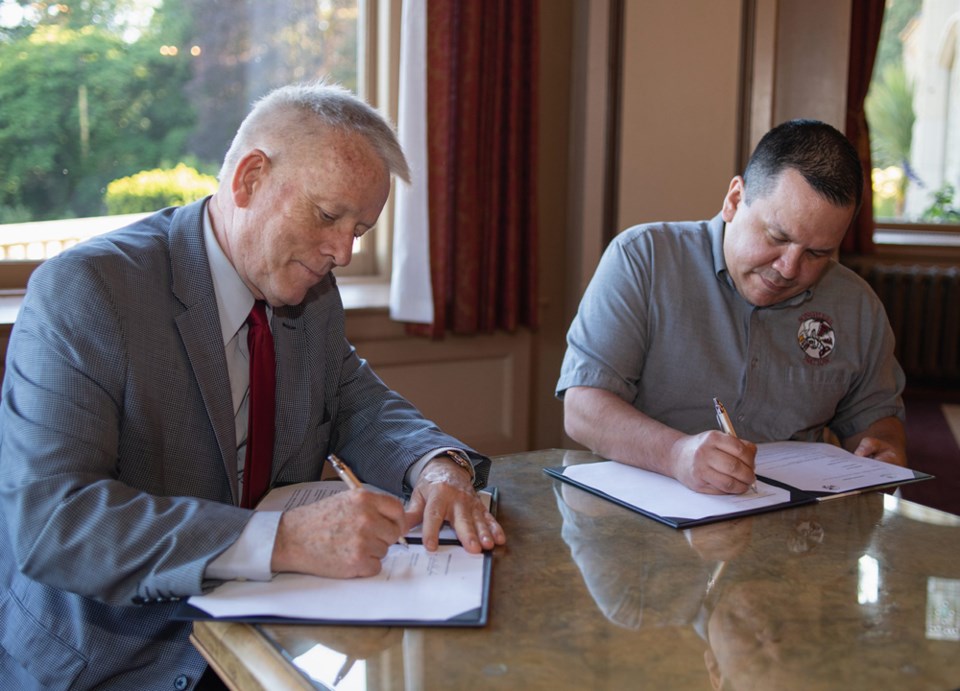Royal Roads University and the Songhees Nation are closer to an agreement over land occupied by the university, with the two signing a “framework agreement” Tuesday.
The agreement is being billed as a planning guide to allow the university and the Songhees people to realize mutual benefits from the approximately 565 acres owned, but declared surplus, by the Department of National Defence.
A key objective of the university is to become owner of the 170 to 180 acres occupied by its campus, including Hatley Castle, the residence building and classroom spaces.
“This is good news,” said Royal Roads University president and vice chancellor Allan Cahoon at a press conference on Tuesday.
Cahoon said the heritage buildings, the gardens and the seaside setting have become an integral part of the Royal Roads educational experience.
Songhees Chief Ron Sam said the framework is a collaborative agreement that will allow the university and his people to realize benefits from the land.
“We are working in collaboration with Royal Roads University to see how their long-term vision can happen,” Sam said.
“But this also gives us a chance to share our vision as a community and as a people.”
The Department of Defence operated Royal Roads Military College for the training of officers on the site from 1940 to 1995 when the university was formed as a distance education institute for post-graduate and mid-career study.
Prior to the Defence Department, the land was owned by Vancouver Island coal baron James Dunsmuir who purchased it in 1907 and built the original castle.
The grounds, much of it forest overlooking Esquimalt Lagoon bird sanctuary, have long been a popular hiking and nature spot.
In 1995, before formation of the university had been announced, a rumour about the impending construction of 8,000 residence units saw protesters barricade themselves inside Hatley Castle for a day.
Sam acknowledged community nervousness over the ultimate use of the property. But he said his people have no intention of doing anything on their own without consultation with the Esquimalt Nation and the City of Colwood.
“A lot of people hear ‘Royal Roads lands’ and they think we are going to just take it over, kick out the university and do whatever we want,” said Sam. “That is not what this is all about.”
“This land is also an ecosystem and, in my opinion, that is something becoming quite rare,” he said.
Sam said the Songhees people began negotiations with the federal government and the province 24 years ago hoping to strike to a modern treaty. Some of the people who began that process have died.
Only about 350 of the 650 Songhees people can live on reserve lands, 126 acres on Admirals Road and some small islands. There is not enough housing, or money to build houses.
But with agreements in place over what the disposition of the land should look like, Sam said he hopes the federal government might speed things up.
Perhaps it could be wrapped within two years. “This is the first step and I’m hoping it will speed things up with the federal government,” said Sam.
Colwood Mayor Carol Hamilton said the city has held discussions with the Songhees Nation in the past. About one year ago, the two groups signed their own memorandum of understanding.
Hamilton said the memorandum is not a binding guarantee. But it is proof of good communication and respect.
She recalls a meeting with Sam and the children of Colwood Elementary School who were worried the forest would be clearcut and its animal residents be put out of their homes. Sam assured the children that wasn’t in the Songhees plans.
“Sure I know there is a lot of apprehension in the community,” said Hamilton.
“But when leaders demonstrate good collaboration, we can put a lot of fears to rest.”



